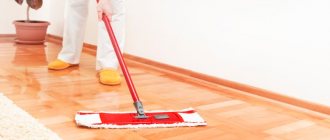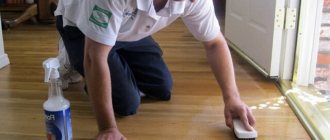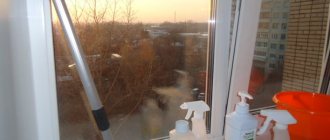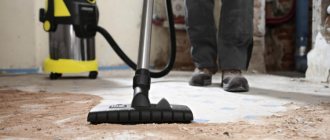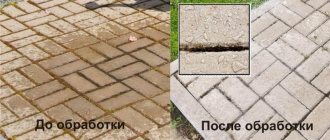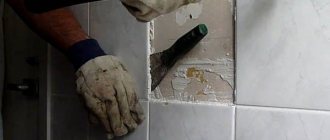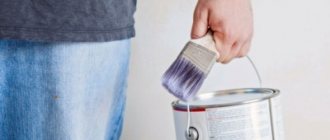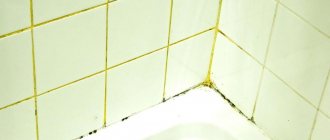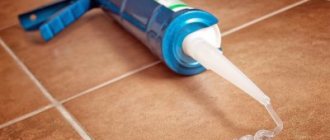How to clean tiles after grout repair?
To avoid problems with cleaning grout from the surface of ceramic tiles, you should remember that such contaminants are most easily and quickly removed during the repair process, before the building mixture has had time to harden.
After tiling a small area, you should check how well the mortar has set and begin removing dirty drops and marks on the ceramic surface. To check the condition of the grout:
- Lightly dampen the seam with a damp cloth.
- Observe the behavior of the material.
Important! Evaluate the result based on the following criteria:
- If the grout begins to swell and extend beyond the boundaries of the seam, then this behavior of the building material indicates insufficient hardening and a low degree of adhesion.
- If you don’t notice any changes after soaking, then everything is fine and you can start cleaning the surface from any remaining building material.
Grout removal technologies
You can clean the tiles from grout after repair in two stages:
- Dry cleaning. This procedure is carried out after laying a small section of tile by wiping the surfaces using a special grater. The tool is held at right angles to the coating.
Important! It is recommended to carry out cleaning movements diagonally to the surface of the seams. This direction will help you avoid damage to grout that has not hardened completely.
- Washing the surface. Wet cleaning of the tile surface should begin after the grout has partially hardened. For this procedure, it is recommended to use a piece of foam rubber, which is generously moistened with water.
Important! Remove any remaining dirt from the glossy surface with a hard cloth, felt or burlap. This procedure will avoid streaks on the smooth surface of the tiles.
How to clean tiles with a relief surface?
Above we talked about how to wipe grout off tiles and tiles with a flat, smooth surface. What to do if a tile with a relief face was chosen for cladding. If it has a textured or rough structure, it is important not to allow the fugue on the tile to harden.
While its trace is fresh, you can use water and flexible. Although the wet removal method will be labor-intensive, it will help to obtain the expected effect. If the tile has a decorative pattern, use abrasives, chemical compounds, and strong compounds. They are able to erase the designs applied to the tiles.
If the fugue has already dried, it will not be possible to simply wash the tiles with water. In this case, it is best to use a rag generously soaked in regular oil. And even though cleansing will be labor-intensive, the oil will quickly soften the dried fugue and allow it to be removed. Matte rough tiles should be washed with special gentle products used for washing difficult surfaces. The cleaner is simply applied not to the seam, but to the tile with a soft foam sponge, then wipe the surface with circular movements, removing any remaining fugue.
Available means
Let's figure out how to clean the tiles from grout. It is easiest to complete the work if cement-based grouts were used during the repair process. To remove them, you can use the following methods:
Take 100 ml for 2 liters of warm water. regular table vinegar (9%). Prepare the solution. Wipe the tiles with a soft cloth or sponge. We often rinse the rag or sponge in the solution and wring it out well; it should be damp, not wet. If traces of grout have dried and cannot be washed off, you just need to apply a rag soaked in the solution to them for a few minutes, then scrape off the composition with a spatula, and wipe off the residue using a rough layer of a dish sponge.
- If the most stubborn traces of grout remain in some areas of the ceramic coating, then it is worth applying soda slurry to them. To do this, mix soda with water until you obtain a mass similar in consistency to toothpaste. Apply the paste to the stained areas, and after 20-30 minutes wash off with vinegar water. This product is suitable for cleaning floor coverings, since soda slurry will not stick to walls.
- To soften traces of old grout on tiles, it is recommended to use diluted glycerin. It is mixed with water in a ratio of one to three and applied to the stained areas. After 15 minutes, the softened grout is carefully removed with a spatula, and the surfaces are washed with water. Similarly, you can use a soap solution prepared from 10 g. grated laundry soap, and 0.5 liters of water.
- To wash away traces of cement grout on tiles, use a solution of ammonia. It is prepared from a liter of water and a tablespoon of ammonia. The walls or floor are washed with the prepared solution.
Features of different types of grout
How long it takes for the grout to dry depends on its type. Every year new products with improved characteristics appear from different manufacturers.
Now we are considering the main types of grout:
- Cement - based on Portland cement and sand. It also has additional modifying components. This is the most popular type of grout, which is represented by universal compounds from well-known manufacturers.
- Latex is an improved option; it has properties that repel moisture, making it great for baths, saunas, and kitchens.
- Epoxy is in second place after cement, but is more often used in production work, since it costs more and is more difficult to work with. It is characterized by high strength and resistance to moisture.
- Furan is a super-dense black composition that is resistant to aggressive chemicals. It is not used at home.
The best option for home work is a dry cement mixture. It is mixed with water in the proportions indicated on the package. You can mix the components with a drill with an attachment, a mixer or a regular spatula.
Depending on how long the composition dries, there is some time for the formation of the correct seam. It should not go onto the tiles, unless the goal is to hide defects. You need to look at the type of tile cut. It is best to fill the seam completely, leveling the surface so that the material absorbs less dirt.
Available means
For minor fresh stains, you can use proven folk recipes that are always available at home.
Laundry soap
Laundry soap removes yellowness and whitens tiles well. It is enough to rub a brush or sponge with a bar of soap and treat the surface. The product gives a thick foam and stays on the surface for a long time. Leave the applied soap for 30-40 minutes, rinse with water and wipe the tiles dry.
Vinegar
Acetic acid is successfully used to clean limescale from cladding. Vinegar is applied from a spray bottle or sponge. As a rule, the surface must be rubbed. If the plaque is relatively fresh, vinegar will remove it.
In combination with salt, vinegar is effective against rusty plaque.
A napkin or rag is well moistened with vinegar, dipped in fine salt and carefully wiped off the rusty stains. An aqueous solution of vinegar is suitable for everyday tile care: the ingredients are mixed in equal parts and poured into a container with a spray bottle.
The product can be sprayed on wall tiles and tile joints daily.
Baking or soda ash
Baking soda can remove grease, fresh rust, mold, dirt and water stone. Before treatment, the surface of the tile is moistened with water. Pour soda onto a wet sponge and rub the stained areas. The product is left for 15 – 30 minutes. During this time, the plaque usually softens and is easily wiped off with the hard side of a dish sponge or brush.
Hydrogen peroxide
Pharmacy 3% peroxide whitens yellowed seams, colored stains or traces of hair dye. On porous tiles, stains will have to be treated several times. The peroxide is gradually absorbed into the pores and after 3–4 applications, the stains usually noticeably lighten or disappear.
Ammonia
Ammonia is often included in liquids for washing glass, mirrors and other glossy surfaces. By itself, it does not remove stains well, but it is added to prevent streaks after washing. An aqueous solution of ammonia (2 tablespoons per 1 liter of water) is suitable for finishing the tiles after basic cleaning.
Lemon acid
Lemon or citric acid softens limescale and gives a slight whitening effect. Sprinkle the powder onto a sponge and wipe the tiles. In this way, you can wash the tiles from fresh deposits in 2-3 minutes.
Tea tree oil
Tea tree essential oil is known for its antibacterial and antifungal properties. It can be used pure or added to household and industrial cleaning products. Regular use of tea tree oil is a good prevention of mold.
From construction dust and whitewash
Construction dust appears during any type of repair, even when rearranging. It is easier to wash off than other types of stains, but you will still have to make an effort.
Note ! Before cleaning glossy, matte, or textured tiles, be sure to scrape off the dried layer of caulk, foam, or lime with a sharp object, but be careful not to scratch the tile surface.
Cleaning the floor from fresh construction dust with soapy water
It is important to remove any contamination as soon as possible, before it has time to eat into the upper part of the tile.
Soap solution
First of all, sweep out all the dust and large debris, and then start treating with a soap solution, which can be done by adding soap or powder to water:
- Pour water into a bucket.
- Add 1 grated bar of laundry soap or 150 g of powder.
- Stir with your hand or a stick until the powder crystals/soap dissolve.
- Mopping the floor.
- Change the water and repeat the procedure 2-3 more times to wash off any remaining foam and avoid streaks.
The recipe is suitable for washing glossy or porous, ceramic, PVC, quartz vinyl, porcelain tile surfaces, provided that the dirt is fresh. This method is well suited for cleaning kitchens from construction dust, minor rust and grease.
Citric acid or vinegar
You can wipe off construction dust from tiles after renovation using acids that corrode dirt.
Cleaning with vinegar and citric acid
The recipe is suitable for dried stains on light/dark, rough or smooth surfaces.
- Dissolve 25 g of citric acid and ¾ tbsp in a bucket of water. table vinegar.
- Stir until the crystals dissolve.
- We soak a rag in the solution and wash the contaminated surface.
- After 15 minutes, rinse with clean water.
This composition removes many types of contaminants and even old deposits from construction dust. Additionally, citric acid will add shine to the surface and hide scratches.
Any of these recipes is suitable for removing limescale marks on tiles.
Note! Considering that lime (chalk) leaves streaks, rinse the contaminated areas several times, preparing a fresh solution.
How to remove glue from tiles
Compared to construction dust, glue is more resistant to many types of cleaning agents, but fresh drops can be wiped off with plain water, alternating with rubbing with a spatula.
Bringing the tiles to life
For more intense stains, use ammonia or acetone.
Remove dried stains as follows:
- In 1 l. water add 1/3 bottle of ammonia and 100 ml. vinegar.
- Wet the gauze folded in three with water, wring it out and dip into the prepared solution.
- Apply the fabric to the glue for 10 minutes.
- Rub and rinse.
If you have acetone, paint thinner, or nail polish remover on hand, use it to remove any adhesive from the floor. Soak a piece of cloth in the product and rub the contaminated surface. If the glue stains are old, apply a rag to the stain and let it sit for about 10 minutes.
Note ! When working with solvents, use protective gloves and open the window wide.
From primer, putty
The easiest way to get rid of fresh stains is by washing them with clean or soapy water, but dried ones can only be removed with special means: solvents, alkali.
Alkali
Baking soda
To clean waterproof primer and putty stains, use a soda solution.
- Dissolve 2 tbsp in 1 glass of water. l. soda
- Soak a clean rag in the solution and wipe away the dirt.
- If the stains are dry, apply a “compress” by soaking a cloth in the solution and leave for 10–20 minutes.
- Rub to remove traces of building material.
The method is completely safe for any type of tile, but dissolves even complex stains. To enhance the effect, before processing, scrape off any protruding dried drop of cement or putty with a spatula.
Solvent
This product can even remove paint from glass or tiles. Dampen a clean rag in the liquid, rub the dirt or make a “compress” according to the principle described above. Finally, wash the tiles with soapy water.
Getting rid of sealant and foam
It is convenient to clean sealant or polyurethane foam with white spirit.
Dissolving the consequences of construction
It can be purchased at a hardware store and used to clean paint from tiles, furniture, clothes, and other types of stains.
- We cut off the excess foam and sealant remaining after installation with a sharp object.
- Pour white spirit onto a piece of fabric.
- Rub the contaminated areas.
With the same product you can easily get rid of excess silicone in the seams between tiles, glass, plastic and other materials.
Find out in advance how to remove silicone sealant from your bathtub.
Methods for cleaning ceramics from various contaminants
We will present for review an effective method for cleaning tiles from the most common types of contaminants, using both special products and cleaning methods with improvised materials and substances.
Due to the fact that the cladding of the bathroom walls occurs after the installation of ceramics on the floor, there is a danger that the primer compositions used to prepare the wall surface for finishing will come into contact with fragments of the floor covering. Wipe off stains from dried primer is a serious test of endurance and patience, so you should not allow it to get on the ceramic surface, and if this happens, then you need to remove the spills immediately using ordinary water.
Since tile is a material that is resistant to various types of adverse effects, many products are suitable for washing it
The following methods are used to clean dried primer:
- stains are dissolved with a special remover;
- the primer is washed off with acetone;
- the contamination is treated with a liquid primer;
- use of vinegar essence.
To make the dried primer easier to remove, the contaminated areas are covered with a wet rag, and some time is given to soften the dried stains.
Particularly difficult areas can be cleaned mechanically, namely using a special scraper. It is a device consisting of a handle and interchangeable blades. Pre-soaked stains are carefully removed with a scraper so as not to damage the tile; the tool must be held at an angle of 30 degrees to the surface of the tile.
Cement mortar that has not set is easily washed off with a wet sponge or rag and clean water. But you will have to tinker with the frozen solution:
- Cleaning with special removers.
- Toilet bowl cleaner works well on dried cement mortar.
- Mechanical cleaning method. Traces of the solution are removed with a metal spatula or a metal mesh for washing dishes.
We remind you that when using the mechanical method, the dried solution must first be soaked and when cleaning with metal objects, do not damage the surface of the finishing material.
After repairs, the cement should be removed from the tiles immediately before it has time to harden.
Tile adhesive
- Traditionally, the easiest way to promptly remove glue residues during the installation process is with a wet sponge.
- The frozen glue is soaked in a solution of water and vinegar or ammonia.
- Chemical treatment of contaminated areas with potent substances.
- Mechanical cleaning. Traces of glue are removed using a metal spatula, scraper, metal mesh or fine sandpaper.
Key moment. In “hopeless” cases of strongly set glue stains, it is advisable to use chemical and mechanical methods in combination.
To facilitate the process of cleaning grout from the surface of tiles in the bathroom, you must strictly follow the technology of finishing joints with fugue, do not apply too much grout to the surface to be treated and remove its excess in a timely manner.
First of all, we need to remove traces of glue as soon as possible, especially if we are dealing with ceramic tiles
There are two removal methods:
- Chemical. The method is based on the use of potent, acid-containing substances. Using this method, you need to take into account the properties of the ceramic used and its resistance to acids. We should not forget about safety measures when working with active substances, be sure to use personal protective equipment.
- Mechanical. The method is used to clean heavily dried grout or grout that is resistant to chemicals. The following tools and devices are used:
- metal spatula, brush or scraper;
- various cutting devices with a sharp blade;
- sandpaper or metal abrasive mesh.
Construction dust
The most common and “obligatory” type of pollution after construction and repair work is the presence of construction dust. Removing it is a simple process and does not require the use of any special or potent substances.
It is necessary to remove dust as soon as possible so that dust and dirt do not become embedded.
First, dust is removed from the surface with a dry cloth or using a vacuum cleaner, after which wet processing of the cladding begins, for which the following means are used:
- warm soapy water;
- water with lemon or citric acid added;
- vinegar solution;
- compositions for cleaning glass.
Ceramic tiles should be washed from top to bottom.
What is grout used for?
Do you even need grout for the seams? What functions does it perform and is it possible to do without it altogether? The answer is obvious: it is imperative to seal the joints. But the appearance and quality of processing largely depends on the type of mixture used.
First of all, you need to know how long it takes for tile adhesive to dry, because work can continue only after the surface has initially dried after laying the tiles. Usually a day or two is enough. If a thick layer of mortar was used to tiling the floor in the bathroom, then you can only walk on the tiles on the third day.
Putting the joints between the tiles in the bathroom plays an important role, primarily the following functions are performed:
- protecting the wall from moisture;
- preventing the accumulation of bacteria and the growth of mold or mildew;
- reducing the risk of clogging joints with various types of contaminants;
- increasing the strength of the cladding;
- making the appearance of the surface more decorative.
Depending on the components included in the mixture, the degree of manifestation of certain functional qualities may vary.
Grouting ensures the finish of the cladding and also makes it stronger.
Rules for working with cleaning products
Most grease removers - both homemade and store-bought - can cause an allergic reaction, poisoning, or, if actively inhaled, a burn to the lungs.
To work with household and folk chemicals, you must strictly follow the safety rules:
- Cover your clothes with a long, thick apron;
- be sure to wear rubber gloves;
- do not lower your head low to the surface to be cleaned so that the acid vapors do not burn your throat and lungs;
- read the instructions for the purchased product;
- remove all food products from the table and kitchen counter;
- Make sure that children and pets do not have access to the kitchen.
After cleaning, wash your hands, face and neck very thoroughly, it is even better to take a shower with shampoo and soap. Rinse the gloves thoroughly, wash the apron in the machine. After cleaning the kitchen, it is better to immediately throw all clothes into the washing machine.
Before work, it also makes sense to make sure that the window in the kitchen is open, and if possible, you should also turn on the hood. You should not inhale fumes from household chemicals or vinegar - they can cause a real burn to the larynx and mucous membranes.
After washing the tiles, the window should be left open for at least 30 minutes in winter, and for two hours in summer, so that all the toxic fumes are blown outside.
How to clean fresh grout from tiles
It is best to remove the grout directly during the process of filling the joints, alternating grouting with cleaning. After completing a small amount of work, you need to check whether the solution has set and begin cleaning up dirty marks. To check the condition of the grout, lightly moisten the seam with a damp cloth and observe what happens next. If the grout swells and begins to come out of the seam, it means it has not set enough. If there are no changes, the remains can be deleted.
When the volume of cladding is small, you can begin cleaning after all the grouting has been completed.
The process looks like this:
- Moisten the sponge with water and wipe the surface;
- Remove solid grout residues with an abrasive that does not scratch the surface;
- Rinse the sponge until clean and wipe the tiles again.
During cleaning, it is important to monitor the moisture of the sponge and remove excess water, which can wash away the fresh grout. Glossy tiles can be cleaned the next day after grouting
Glossy tiles can be cleaned the next day after grouting.
How to remove dried grout from tiles
To remove mortar that has hardened in the pores of porcelain tiles or from a glazed surface, there is an acidic cleaner to remove cement residues. Its composition is capable of reacting and dissolving traces of glue, grout and cement that have fallen on the tiles. The product is applied to the surface for 5 minutes, then washed off repeatedly with water.
Features of removing epoxy-based grout
Cleaning tiles from grout containing epoxy resin should be done as soon as possible after processing the joints. There is an epoxy cleaner for this. The agent that dissolves epoxy resin consists of several acids and is quite expensive. But still cheaper than re-purchasing material and new facing work.
If more than 24 hours pass and the grout has completely hardened, the tiles can only be cleaned mechanically.
Handy tools for cleaning tiles
In addition to ready-made products specially produced for removing dirt from tiles, there are common household cleaning products:
- Detergents containing acid - you can find out about their composition from the label;
- Limescale removers are a proven method of cleaning tile grout;
- You can add 1 spoon of white alcohol or kerosene to the water;
- A mixture of water and glycerin (3/1) – eliminates cement stains on tiles;
- Rubbing the tiles with baby soap before grouting the joints protects its surface from contamination. After finishing the work and drying the joints, the tiles must be washed.
It should be noted that it is better to start experiments with removing dirt from a separate tile left over from the renovation. If a satisfactory result is obtained, the proven product can be applied directly to the cladding.
Washing tiles
If there are traces of grout left on the tiles, you can use certain methods to remove them:
- Water with added soap. This option is simple and very effective for washing.
- Liquid with lemon. The glossy surface acquires shine and becomes fragrant.
- Vinegar. It should also be diluted in water to form an acidic composition. This folk remedy copes even with serious stains. In this case, a protective film is formed on the surface.
- Glass cleaner. The option is quite practical and effective, the dirt is perfectly cleaned and there are no streaks left.
How to clean grout - modern methods
The young and advanced generation of tilers does not welcome traditional methods and focuses their work on the recommendations of ceramic manufacturers. But in their principled approach they also forget that all modern means of cleaning ceramic coatings are based on folk recipes.
The cleaning liquid must be applied to the tiles and then removed with a sponge after a certain time.
The acid-base component predominates in the composition of detergents and cleaning products in the current chemical industry. Here are some groups of such funds:
- protective: applied a few hours before the grouting process and after completion of work, removed by washing off along with the remains of the grout;
- cleaning: applied to the uncured grout mixture by applying it to the wall with a sponge;
- removing: used to remove already hardened fugue by applying and leaving for a certain time to soften the areas of contamination.
When working both with recipes of folk craftsmen and with modern cleaning products, you must adhere to certain rules.
- Before you start using any product, test its effect on a sample of the tile you are going to work with. This will save the entire cladding from possible damage and undesirable cleaning results.
- Use personal protective equipment, at least special gloves and a respirator when working with acid-containing solutions.
- When working, use not improvised means, but those tools that are intended for a particular operation.
- Follow the sequence of operations and technology for using cleaning products. This is especially true for factory production.
With proper care of ceramic cladding, it can last for more than one generation, as it is one of the most resistant finishing materials to external factors.
Process:
The first step in removing excess grout is “dry”. Holding the float at almost a right angle to the surface of the tiles, we move it diagonally relative to the seams. If the edge of the float gets into the seam and removes part of the grout from it, add a little grout to the seam and level the surface.
Let the grout in the seams set. You can assess readiness using a sponge: wet it as much as possible and test a small area. If the grout from the joints is pulled behind the sponge, it means that it has not grabbed enough. Wait a few minutes and check again. Wet cleaning can begin when the grout in the joints remains in place. But it should not be hard - otherwise the seams may be damaged during cleaning.
We carry out wet cleaning using a strongly wrung out sponge with soft circular wiping movements. Be careful not to create grooves in the grout joints. Clean only a small area at a time (1-2 square meters in size), rinsing frequently and squeezing the sponge thoroughly. If necessary (if the lining is larger than 9 sq. m.), change the water to clean water.
Let's inspect the grout joints - where they are not neat enough, we level them and smooth them with a joint or the end of a toothbrush. Then we trim the edges of the seams with a sponge, moving it parallel to the seam. We carefully remove the protrusions and fill the recesses with a small amount of grout on the tip of your finger (wear tight-fitting rubber gloves for this). Ideally, all seams should have the same shape and depth, be even on top, and not convex.
Once the seams are leveled, thoroughly clean the surface of the tiles again. We rinse, wring out the sponge well and make one side of it a straight, vertical passage about a meter long, very slowly moving the sponge towards you without stopping. (If you move quickly or intermittently, grout streaks will remain on the surface of the tiles). After the first pass, turn the sponge over to the clean side and make a pass parallel to the first, and then rinse the sponge. For one pass, use the freshly washed side of the sponge. Continue until the entire facing area is completely cleaned. If the sponge pulls the grout out of the seams, it means that there is too much grout and the seams need to be straightened, or there is too much water in the sponge.
Allow the grout to dry for 15 minutes (during this time, streaks will appear on the tiles again) and wipe the tiles with a soft, clean cloth. If the tiles have a matte finish or rounded corners, an additional pass with fresh water and a sponge may be necessary.
If the grout residue is difficult to clean, you didn't clean the surface well enough the first time, or there was adhesive left on the surface of the tile and the grout has set more than usual. Try removing residue with a damp abrasive float or use acidic cleaners. But keep in mind that the grout in the joints must fully set before using them.
After a few days, when the grout has completely hardened, the seams can be covered with sealant. Use a small brush for this. Remove any excess sealant that may accidentally end up on the tile surface immediately.
If you are wondering how long it takes for tile grout to dry, you need to take into account its properties. Different types of materials in this group harden at different rates, which is due to differences in structure and composition.
When installation work continues ahead of schedule, when the grout has not yet dried, this may cause a reduction in the service life of the coating. As a result, after some time you will have to make repairs or re-lay the cladding on the wall/floor.
Recommended cleaning times
Removal of the grout layer is carried out in several stages - from the initial removal of excess to dry and wet cleaning. It is better to carry out the first stage when the material has not yet hardened, but has already hardened sufficiently. In this case, the risks of damaging the surface of the tile and disrupting the hardening process of the putty are minimized.
It’s easy to check the condition of the seams - just moisten them with a damp cloth and evaluate the reaction.
If, after interacting with the liquid, the grout mass begins to increase in size and extend beyond the seam, it is too early to begin cosmetic work. If the layer remains unchanged and does not react to water in any way, then the moment for cleaning is most suitable.
Reference! The average initial setting time for tile grout is about 30 minutes.
When can you start cleaning?
To complete the work, you need to clean the surface of the tiles from excess material. It is permissible to carry out this after as long as necessary for final drying.
Wet cleaning is carried out after 2 days, full cleaning – on the 7th day. You can understand when you can wet the joints and use detergents using the visual method. You should see how much lighter the mass has become, but not in the seams, but the one that remains after work. When it has already begun to change color and harden, you can begin cleaning.
Cleaning products
To care for a tiled surface, the easiest way is to use ready-made special products that are sold in household chemical stores. They are ready for use and do not need to be diluted or mixed with other substances. However, there are no universal ones among them, so before purchasing you should carefully study their purpose.
A good product must meet the following requirements:
- Be gel-like or liquid. It is better to avoid the use of powders and abrasive pastes, because they spoil the glaze layer, and over time the tile will lose its shine, the gloss layer will be erased irrevocably.
- It is desirable that it contains chlorine. This component makes the product almost universal, because... not only helps to cope with various contaminants, but also destroys bacteria and unpleasant odors.
- Does not contain chalk. Many housewives have long abandoned the use of chalk to clean tiles, because to wipe off the white coating on the tiles will require additional time and effort.
- Does not contain acids. Their impact destroys the layer of putty and grout in the seams.
How to avoid mistakes and not affect the drying time?
To avoid thickening of the layer of material in the space between the tiles, you should use special tools for applying grout:
- Rubber spatula - used in most cases, but due to its small width it is not recommended to use it if you plan to perform a large amount of work. A spatula with these characteristics is suitable for applying different materials.
- Grater - used when finishing mosaics, since in this case the use of a spatula increases the installation time. A construction float is also suitable for filling joints in large areas, which allows you to speed up work.
- Syringe gun - designed for filling deep seams. This tool is often used for applying polyurethane and silicone mixtures; thanks to it, neat seam joints are obtained.
- A cone is an alternative to a pistol. This option is suitable for cases where it is necessary to protect porous base material.
How to care for tiles
In order for the coating to last for a long time, you need to know how to properly care for tiles.
For glossy structures, strong acid-based detergents should not be used. This may damage the gaps and seams between the products.
It is best to purchase special products for tiles, ceramic tiles and porcelain tiles.
Do not use metal brushes or abrasive powders because they will severely scratch the surface of the coating. This is especially noticeable on glossy ceramic tiles.
The Best Tile Cleaners
To ensure that the tiles retain their attractive appearance for a long time and do not fade, it is better to use specialized mild detergents:
- Mister Muscle. Eliminates plaque, rust, removes stains from the surface of tiles and gives it shine. It is necessary to apply the liquid to the dirt, wait 3-5 minutes and walk again with a damp sponge. It copes well with old, stubborn stains and does not run off vertical surfaces. In this case, there is no need to scrape and rub the plaque with a washcloth. The detergent perfectly removes even formed mold from the grout.
- Frosch. Suitable for most types of tiles. Effectively removes dirt, grease, stains and plaque from ceramic tiles. Frosch is harmless to the body. The product neutralizes unpleasant odors and kills germs. To clean the tiles from dirt, dilute 2 caps of detergent in 5 liters of water and clean the surface. Not intended for use in its pure form.
- Cif Anti-plaque. Removes accumulated dirt thanks to a unique water- and dirt-repellent formula. In a matter of seconds it will remove limescale and soap stains from the surface of the tile. SIF should be applied evenly to the dirt, wait 5 minutes and rinse with clean water.
- Domestos. Effectively eliminates fungus, whitens grout joints between tiles and disinfects. Directions for use: Dilute 2 caps of gel in a five-liter bucket of water and remove dirt with a sponge or soft-bristled brush. Then rinse the surface with water and wipe dry.
- San-klin (Santik). Liquid for removing limescale, rust and other contaminants from tiles. It must be applied to the surface for 5-10 minutes and then remove any remaining dirt.
You can also use the following aids to clean tiles:
- Bleaching powder. Dilute the powder with clean water. Pour the solution into a spray bottle and spray it onto the desired surface. Then leave for five minutes and rinse with plenty of clean water. Let the ceramics dry or wipe the surface with a dry cloth. Chlorine solution kills germs and gets rid of mold.
- Melamine sponge. Easily wipes off minor stains, removes limescale and does not spoil the appearance of the cladding. You just need to wet the sponge and rub away the dirt.
- Steam cleaner. A gentle alternative to aggressive cleaning liquids. Steam cleans the tile surface no worse than chemicals. And at the same time it does not have any mechanical effect. Steam supplied under high pressure dilutes grease stains on the tiles and disinfects the surface being cleaned, killing germs. The steam cleaner is excellent at removing mold and limescale in the bathroom. It easily removes even greasy stains in the kitchen.
To prevent ceramics from fading and scratches appearing on it during use, you need to treat it with a special varnish. A durable protective coating is created, the color does not change for many years, and caring for the tile surface is greatly simplified because almost no dirt accumulates on the varnish coating.
With proper cleaning and good timely care, ceramic tiles will last for many years.
Ceresit
Ceresit grouts are now popular and well-known on the market; there are six main types of grout of this brand.
Ceresit grout is used on vertical and horizontal surfaces
- Ceresit CE 40 Aquastatic. Suitable for laying widths up to 10 mm, withstands high and low temperatures and their differences, suitable for heated floors and outdoors.
- Ceresit CE 43 Super Strong. High-strength fugue, seams from 4 to 20 mm thick. Suitable for any weather and temperature conditions, not recommended for use with marble and glazed tiles.
- Ceresit CE 35 Super. Thickness from 0.4 to 15 mm. Suitable for grouting tiles in swimming pools, combined with marble and stone.
- Ceresit CE 33 Super. For seams up to 5 mm, suitable for kitchens and bathrooms. Can be used for external walls.
- Ceresit CS 25. Silicone-based fugue, can be used in bathtubs and showers, joint thickness from 4 to 30 mm.
- Ceresit CE 79 UltraPox. Epoxy fugue. Resistant to chemical and mechanical influences.
The disadvantage of Ceresit grout is the frequent difference in color before and after application, so it is better to buy it in stores where the grout can be tested before installation.
Removing simple stains
If there are severe stains and those that are not even spots, but lumps, a spatula will do. It is necessary to remove the sagging by carefully prying each one up. The main thing is not to rush and perform all movements at a smooth pace, otherwise you may not calculate your efforts and leave scratches on the tile, which will be very unpleasant. This technique is suitable for removing solutions mixed with water.
The situation is different with polyurethane compounds. Cleaning also involves gently prying, but then slightly tugging and removing from the surface. No cleaner will cope with the task at this stage, since it makes no sense to dissolve heavy deposits.
But the grout may not appear as clumps on the tiled surface, but only as drops or spots. They can also be cleaned mechanically.
Before you clean the grout from the tiles, you need to prepare:
- container with warm water;
- clean rags;
- gloves;
- putty knife.
Using a spatula, they try to crush the integral structure of the stains. After that, they soak a piece of cloth and, rubbing the stains in a circular motion, begin to fight simple stains on the tiles. In addition, to clean small stains, you can apply cloths soaked in the product.
Typically, cleaning tiles with a relief surface involves the use of special solvents and acids. However, the inconvenience is that the composition gets clogged between the porous tile structure. You can go over the matte surface with a brush or sponge. But it is not recommended to do this with glaze.
There is a special grout remover available in stores. Moreover, the range of such products is quite wide. These are potent solutions for different types of textures and surfaces, based on alkali or acid (or both). Each such product has an action interval strictly defined by the manufacturer, which cannot be either underestimated or exceeded when applying the drug to a tiled layer of dirt.
Basically, chemical industry products are used when it is not possible to remove the grout from tiles with a grooved side using mechanical methods. To apply the composition use a sponge or brush. The product is applied pointwise. If there is a large area of contamination, work is carried out on an accessible area, limiting the treatment to two square meters. Gradually covering other zones. It is easier to work with small areas, if only because the rubbed area of dirt will not have time to dry at the very beginning while working with stains throughout the entire area. After applying the product to the traces of the grout mixture, there is no need to wait longer than the time specified by the manufacturer of the product. Because otherwise it will be problematic to wash the tiles after repairs.
Features of grouting relief tiles
Before you start grouting, you need to let the tile adhesive completely harden. The joints must be clean. The facing material is sealed with protective film and masking tape. This is done because it is almost impossible to remove the remains of frozen materials from this tile. Or scraping off the hardened mass can damage or scratch the slab.
Seal the seams with masking tape
Before carrying out work to clean grout contamination from tiles, you should adhere to the following recommendations:
- Clean the tiles from bottom to top, and wipe and rinse the other way around.
- Hands should be protected with rubber gloves.
- For glossy and embossed slabs, soft-bristled brushes and foam sponges are used. Do not use detergents that contain abrasive pigments; they contribute to the appearance of cracks on the tiles.
- To avoid damaging the grout joints of the tiles, protection in the form of epoxy paint should be used. It creates an impenetrable film even for acid-containing products.
- When using household chemicals, dilute it strictly according to the instructions.
- There is no need to wash the tiles with products that contain fats.
- To dry washed joints, it is better to use a terry or cotton towel.
- To bleach the grout, use pharmacy hydrogen peroxide, which is not washed off.
- It is important to study the instructions for working with tiles and grout material.
If there are traces of grout left on the tiled surface, they can be washed off in a variety of ways.
Do not use metal brushes
Rinse the tiles with a foam sponge, after the surface is wet, use a spatula or scraper to collect all excess. In this case, the device must be kept parallel to the plane. The remaining stains are wiped with a sponge and a damp cloth. This method corrects worn joints.
For embossed tiles, you can use a toothbrush and water. This method will help if the grout has not completely hardened.
If stains have formed on the tiled surface, a specialized tool with a metal tip will help get rid of them.
Cleaning fresh grout
Modern grout hardens within 24 hours, so it is easiest to clean it immediately after filling the tile joints. But first, after processing, it is necessary to check the seams for stability. Lightly moisten them and observe the reaction. If no changes appear, you can begin to wash away the dirt.
To do this, lightly wet a soft sponge in water and carefully wipe the tile joints to remove dirt. When removing excess mortar from facing tiles, do not wet the sponge excessively - this can lead to distortion of the seams
If you missed the moment, the cleaned joint has dried out slightly, and white marks appear on the tiles, it is recommended to resort to the following cleaning measures:
- White stains can be washed off well with special felt graters using regular dishwashing detergent or vinegar solution (add 100 grams of vinegar per 2 liters of water).
- Baking soda will help remove grout marks. Apply a little soda to the slightly moistened surface of the tile and begin the scrubbing process in a circular motion.
- A felt grater soaked in vegetable oil will help in the fight against dirt on embossed tiles.
